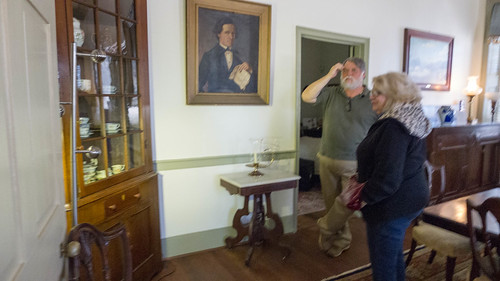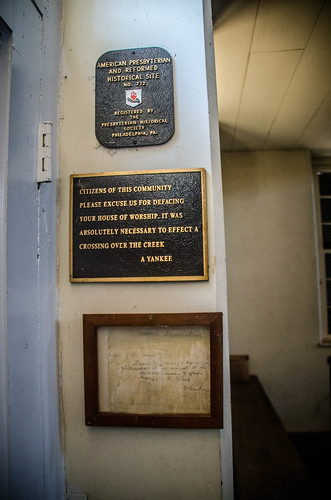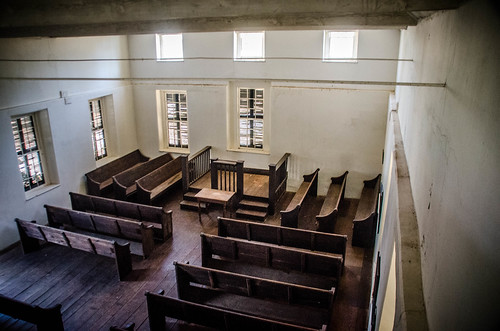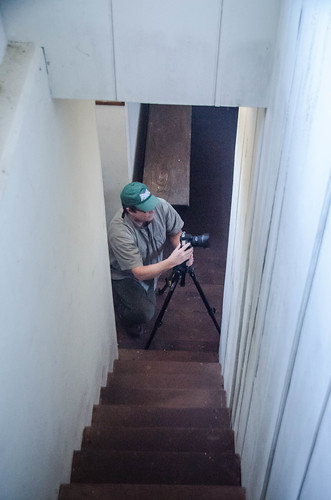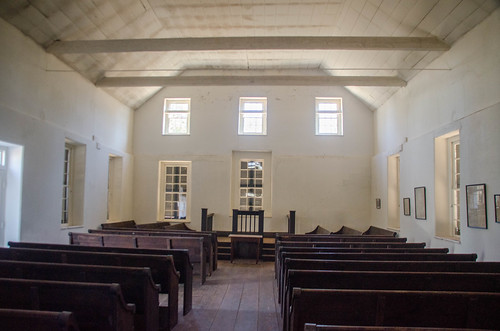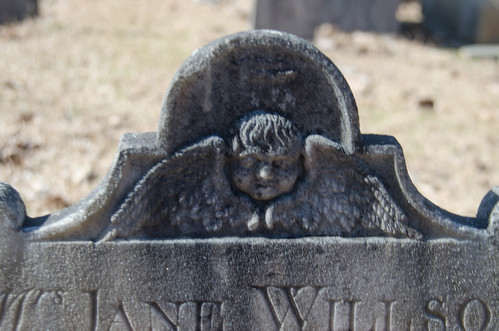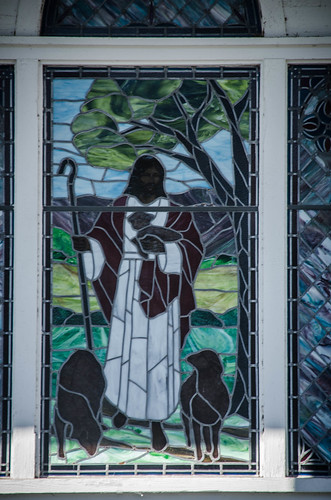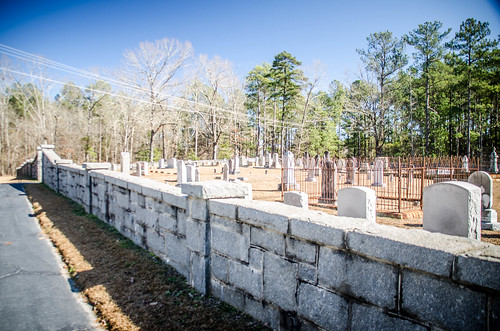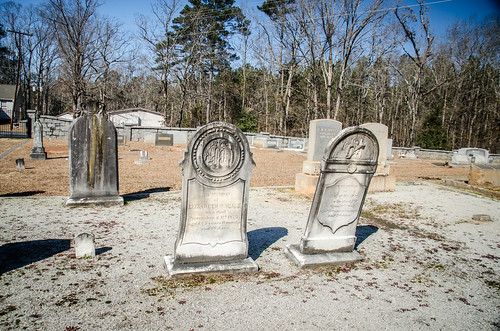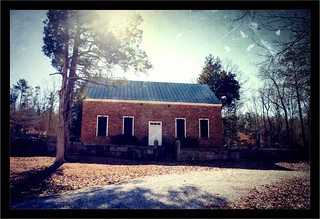Earlier this morning we had been granted access to the Mount Zion Institute, a historic school in Winnsboro now threatened with demolition. Sabi Cathcart and Pelham Lyles had been gracious enough to let Bennie Brawley, my sister Glynda, and I into the historic building. Our tour of the school had ended, but it was still early. We had time for more exploration.
Our group re-adjourned at the Fairfield County Museum. First, though, I took Glynda on a quick driving tour of the town. She agreed with my assessment from previous visits. There are stark contrasts, with some gorgeous old homes on one side of the town, and blighted areas in the other. The downtown is the most depressing, though, with all of the empty storefronts.
As we parked at the museum Glynda noticed the building next door, the Christ Central Community Center. I had just photographed it yesterday as another example of Winnsboro Blue Granite. She, however, noticed that the entryway looked like the entrance to a movie theater. Despite the later addition of stained glass by the church that now controls the site, it does have that look about it. Folks in the museum confirmed that this was once a historically black theater in the days of segregation. I missed those comments, so I didn’t get all the details, and I haven’t been able to find any more information online. I to know that the theater is used as a meeting hall by the museum.
Inside we waited for our group to gather. In the meantime Glynda got the tour of the facility from Pelham and I tagged along. We showed her the bottles that I had donated and how they fit into the display. I also got some additional information.
On our visit last year Houston, Alan, and I had photographed an old house across the street quite extensively. It looked like there was an attempt at repairs. A year later, it looks like those repairs had gotten nowhere. Inside the museum was a large portrait and a bust of a Mrs. Wolfe, who had lived in the house.
We were standing in the hallway upstairs when a gentleman emerged from the genealogy room and asked if he could help us. We explained that we were waiting for others, but he insisted on giving us another tour. Eddie Killian is the president of the Fairfield Genealogical Society, and assists in the research room at the museum. Seems folks are proud of their museum and all of them want to show it off. Rightly so.
Eddie took us up to the “forbidden” third floor of the museum. There he showed us Ed Gates’s restoration room, more research areas, and a room for storing items that weren’t on display.
When I mentioned about the donation of the Shivar bottles Eddie was able to find me some valuable information. I’d had Shelton on my list of ghost towns for quite awhile, but never really had any info on it. Eddie pulled out two articles with photos of the town in the 1930s. Now I’m even more interested in a re-visit.
Sabi’s wife, Claudia arrived, and we continued to wait for Bennie. We had made arrangements for Sabi to let us into Ebenezer ARP Church near Jenkinsville, aka “The Old Brick Church.” We figured Bennie had either gotten lost or distracted by photography. Turns out it was both. He eventually got there, and we set off for the Jenkinsville area.
Sabi opened the door for us and we headed on in. The church is quite simple. There is a raised pulpit with flanking pews for choir, and other simple pews for congregation. That’s it. A balcony lines the back wall, and once served as a slave gallery.
Sabi explained that this church didn’t allow musical instruments, although Claudia added that they had brought in a piano for one special service. She seemed to indicate that it would be the last time, due to all the trouble they had getting it there and set up. Sabi also said that there had been an additional balcony at the front of the church for the choir. You can see the outline of the stairs on the wall to the right of the pulpit.
I walked to the back of the church. There I found three plaques commemorating and event from the Civil War. It seems that some of Sherman’s troops came through and took some planks from the church to build a bridge. They left a hand-written apology on the door which reads…
Citizens of this Community,
Please excuse the defacing of your house of worship. It was absolutely necessary to effect a crossing over the creek.
A Yankee.
The display included the framed original note.
I climbed on up the narrow stairway to the low balcony. Several rough wooden benches served as the only furniture.
Bennie had caught up with us, and had set up to do more long exposure and HDR shots with his tripod.
Other resolutions and historical documents were framed on the walls of the church. I noticed that the name “Crumpton” was prominent in these documents, and wondered if they might be related our our school district’s former superintendent, Sid Crumpton. I believe he was from this area.
Glynda, Sabi, and Claudia had moved outside and were looking at the gravestones. I didn’t linger too long, as we had photographed these extensively last year on our visit. I did make note of one 1825 headstone with a “winged souls” motif.
Glynda had snagged my little camera and had taken some exterior shots, including some that contrasted the brick of the church with the green and bright red of a nandina bush.
The whole Walker/White clan of stonemasons is represented in the cemetery, including a stone by the firm of Rowe & White, stonemasons for the Fireproof Building in Charleston.
Services are no longer held at Ebenezer, but they do have an annual service. Sabi said he would let me know when that takes place. I told him I’d love to come down for that one.
Both Sabi and Claudia Cathcart were wonderful hosts, allowing us to come in, take photos, and provide information about the places we visited. Sabi spent the entire day with us, letting us into Mount Zion Institute, as well sticking around to let us into Ebenezer. They are great folks.
I also enjoyed meeting Bennie Brawley in person. I had admired his photos online for awhile, and it’s great to meet the person responsible.
Glynda and I had one more stop. Little River Baptist Church is just a couple of miles away from Ebenezer. Like Ebenezer, it is an old church, and is on the National Register of Historic Places. As many times as I’ve explored this area, I don’t think I had stopped by.
The church is a classic Greek Revival white frame building, built around 1845. Rev. James Clement Furman, president of Furman University, dedicated the building. When I think about it, that makes sense, because Furman was in Winnsboro at the time.
When we saw the stained glass on the front of the building, Glynda wondered if this were an African American congregation. Jesus looked distinctly black. I told her I didn’t think so (and confirmed that later when I found out Furman was involved.). The stained glass has aged, and wouldn’t have the same appearance outside as it would indoors with the light streaming in. Or perhaps they were true progressives and depicted Jesus as middle eastern person with dark complexion. However, I’m afraid it was the former.
Glynda was getting tired so she stayed in the car while I did a brief walk through the cemetery. There were some old stones, but not nearly as old as Ebenezer’s. A Winnsboro Blue Granite wall surrounded the cemetery.
It had been a fantastic couple of days exploring. I was very glad I’d driven back down here for the second day. I met some great folks, and got a chance to explore places that would normally be off limits. Even more promising, I’ve been invited back to visit other sites in Fairfield County with greater access. I’m looking forward to more visits






